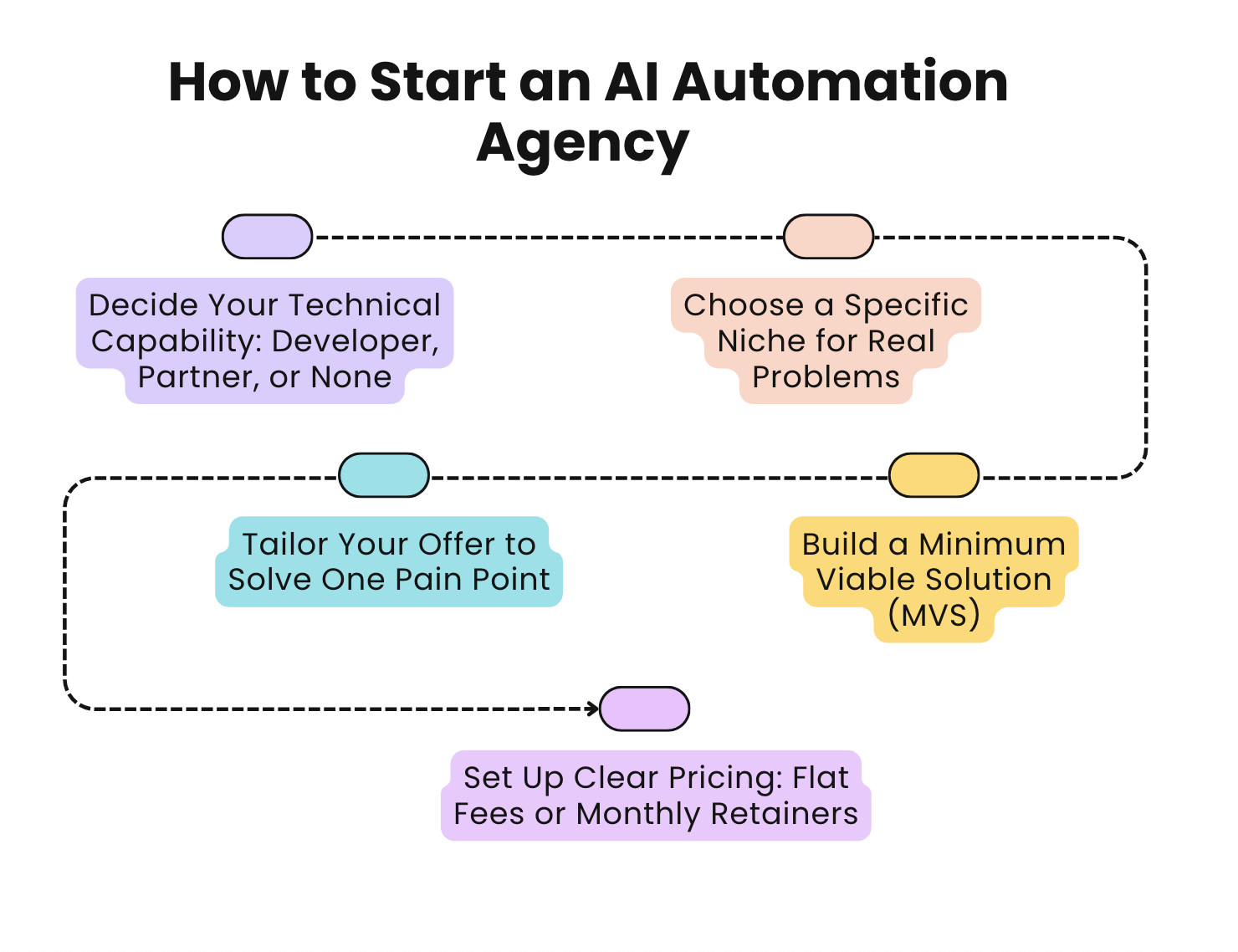
Start an AI Automation Agency in 7 Days: Step-by-Step Guide
Why AI Automation Agencies Are Growing
Businesses today are under pressure to move faster while reducing costs. Manual processes in marketing, operations, and customer support limit efficiency. Artificial Intelligence tools make it possible to automate repetitive work, personalise communication, and scale decisions with data. This is why demand for AI automation services has increased among startups, enterprises, and B2B brands.
An AI automation agency helps organisations adopt the right tools and strategies to improve efficiency and growth. Companies like Product Siddha have already shown how combining product management skills with automation expertise can transform businesses. In one of their client cases, Product Siddha streamlined a SaaS firm’s onboarding workflow using AI-driven communication, resulting in a nearly 25% reduction in customer drop-offs.
If you want to build a business in this space, you do not need years of preparation. With a focused approach, it is possible to launch an AI automation agency in a single week.
Day 1 – Define Your Niche and Value
The first day should be devoted to clarity. AI automation covers several areas:
- Sales outreach
- Customer support
- Marketing campaigns
- Workflow automation
- Data-driven decision support
Instead of offering everything at once, begin by choosing a focused niche. For example, you may specialise in AI-powered email automation for B2B sales or chatbot solutions for e-commerce brands.
Your value proposition should be clear in one line. Example: “We help subscription brands reduce churn with AI-driven lifecycle automation.” This helps you stand out in a competitive market.
Day 2 – Set Up the Business Foundation
Once you have your niche, focus on the structure of your agency.
- Register a simple business entity.
- Secure a professional domain name and create a website.
- Use clear positioning on your homepage with services, case studies, and contact details.
If you do not have a portfolio yet, highlight your methodology and include insights from trusted partners. Product Siddha often showcases frameworks, not just results, which builds credibility with clients.
Day 3 – Choose Tools and Platforms
Your agency is only as strong as the tools it deploys. On day three, select platforms that allow you to deliver automation with reliability.
Some common categories include:
- CRM Automation: HubSpot, Zoho, Salesforce
- Email and Marketing Automation: ActiveCampaign, Klaviyo, Mailchimp with AI add-ons
- Workflow Automation: Zapier, Make (formerly Integromat), n8n
- AI Enhancements: GPT-based assistants, custom models, AI scheduling tools
You do not need every tool. Begin with one or two and master them. For instance, Product Siddha often integrates CRM data with automated workflows to give B2B firms a complete view of their funnel.
Day 4 – Build a Pilot Solution
Rather than preparing documents or long proposals, create a working pilot on day four.
Example projects:
- An automated email sequence triggered by customer actions.
- A chatbot that qualifies leads before routing them to sales.
- A dashboard that pulls customer feedback into one view.
This pilot will act as your showcase when speaking with clients. It demonstrates practical knowledge rather than just theory.
Day 5 – Develop Outreach Strategy
Now that you have a foundation and a pilot, you need your first clients. On day five, focus on outreach.
Effective methods:
- LinkedIn connections with personalised messages.
- Cold email campaigns (ironically, a place to use your own automation).
- Partnerships with small agencies that lack AI expertise.
Instead of sending generic emails, focus on pain points. A good message might be: “I noticed your company relies on manual customer follow-ups. We recently helped a SaaS firm cut their drop-off rate by 25% using AI automation. Would you like me to share how?”
This approach mirrors the value-driven outreach style Product Siddha applies in its consulting projects.
Day 6 – Pricing and Packaging
By the sixth day, you should decide how to price your services. Options include:
- Project-based (one-time automation setup).
- Retainer-based (ongoing optimisation and monitoring).
- Hybrid (setup plus monthly support).
Start simple. Offer a pilot project at a fixed cost, then move into retainers. Product Siddha often begins client relationships with a single focused solution before expanding into larger, long-term engagements.
Transparency in pricing builds trust. Avoid over-promising or presenting unclear packages.
Day 7 – Launch and Refine
On the final day, make your presence public.
- Publish your first case study or pilot demo on your website.
- Share practical insights on LinkedIn or industry forums.
- Announce your new agency with a clear service statement.
From here, refinement is ongoing. Collect feedback from early clients, improve processes, and expand capabilities step by step.
Case Study – Scaling Onboarding with AI
Product Siddha shows how intelligent automation can transform user engagement. A growing SaaS brand was struggling with manual onboarding emails. New users were signing up, but most were not completing their activation steps. The support team was overloaded with repeated queries, and conversion from free trial to paid plan remained low.
To address this, Product Siddha designed an AI-powered onboarding sequence. The system tracked user actions inside the product and adjusted email prompts accordingly. A user who skipped setup received a guided walkthrough, while someone who completed setup early received advanced tips and upgrade nudges. The sequence was no longer static but adaptive, ensuring relevance at every stage.
Within the first quarter of implementation, activation rates rose by 27 percent and support tickets related to onboarding dropped by nearly 40 percent. The automation not only reduced internal workload but also created a smoother experience for users.
The key takeaway for businesses exploring AI email marketing is clear: even modest interventions, such as personalised onboarding flows, can generate measurable improvements in engagement, support efficiency, and long-term customer retention.
What You Need to Remember
Starting an AI automation agency in seven days is realistic if you keep the process simple. Focus on:
- Picking one niche.
- Building a quick pilot.
- Reaching out with value-driven communication.
- Learning and refining with every client.
The journey does not end after the first week. Real growth comes from consistent delivery and trust-building. Companies like Product Siddha show that combining technical skill with product management discipline can help businesses adopt automation at scale.
